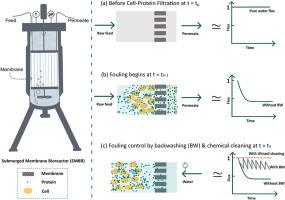水解膜生物反应器中蛋白细胞分离的优化研究
IF 9
1区 工程技术
Q1 ENGINEERING, CHEMICAL
引用次数: 0
摘要
膜污染影响了膜生物反应器中蛋白质细胞的分离效率。对多变量污染机理的全面理解和混合污染物的优化反冲洗(BW)策略尚未得到很好的表征。本文首次采用分数因子设计(FFD)对酵母-牛血清白蛋白(BSA)污染动力学进行了系统研究,分析了酵母和BSA浓度、体重通量、体重持续时间和体重周期这五个关键因素。实验表明,酵母浓度是决定饼层形成过程中通量降低的主要因素,而酵母存在时,BSA对通量的影响最小。BW通量的提高提高了通量,同时减少了BSA的传播,在污染控制和产品回收之间建立了基本的操作平衡。短时间,高频BW有效控制污垢,但过度清洗损害蛋白质的传输。在最佳BW条件下(125 L m−2 h−1通量,每5 min 5 s),系统成功地保持了80 L m−2 h−1的稳定通量,在运行140 min后,BSA回收率为81%,在BSA浓度(8.66 g L−1)下测试,性能比非BW条件提高了20 - 25%。此外,高达40 g L - 1的BSA浓度持续通量为72-80 L m - 2 h - 1, 30分钟内蛋白质传输率为30%。浓度弹性性能表明显著的过程强化潜力,减少足迹和下游整合高滴度蛋白质回收。优越的性能需要多变量优化,以平衡清洁强度和时间为有效的蛋白质细胞分离。本文章由计算机程序翻译,如有差异,请以英文原文为准。

Optimizing protein-cell separation in submerged membrane bioreactor for clarification
Membrane fouling hinders protein-cell separation efficiency in membrane bioreactors. A comprehensive understanding of multi-variable fouling mechanisms and optimized backwashing (BW) strategies for mixed foulants are not well characterized. Here, we present the first systematic investigation using fractional factorial design (FFD) to reveal yeast-bovine serum albumin (BSA) fouling dynamics, analyzing five critical factors: yeast and BSA concentration, BW flux, BW duration, and BW cycle. The experiments reveal that yeast concentration is the dominant factor dictating flux reduction through cake layer formation, while BSA exhibits minimal significance on flux in the presence of yeast. Elevated BW flux enhances flux while simultaneously reducing BSA transmission, establishing a fundamental operational trade-off between fouling control and product recovery. Short-duration, high-frequency BW effectively controls fouling, yet excessive cleaning compromises protein transmission. Under optimal BW conditions (125 L m−2 h−1 flux for 5 s every 5 min), the system successfully maintained a stable flux of 80 L m−2 h−1 with 81 % BSA recovery over 140 min of operation, tested at BSA concentration (8.66 g L−1), demonstrated a 20–25 % performance improvement over non-BW condition. Furthermore, BSA concentrations up to 40 g L−1 sustained fluxes of 72–80 L m−2 h−1 with 30 % protein transmission within 30 min. The concentration-resilient performance indicates significant process intensification potential with reduced footprint and downstream integration for high-titer protein recovery. Superior performance requires multi-variable optimization to balance cleaning intensity and timing for efficient protein-cell separations.
求助全文
通过发布文献求助,成功后即可免费获取论文全文。
去求助
来源期刊

Journal of Membrane Science
工程技术-高分子科学
CiteScore
17.10
自引率
17.90%
发文量
1031
审稿时长
2.5 months
期刊介绍:
The Journal of Membrane Science is a publication that focuses on membrane systems and is aimed at academic and industrial chemists, chemical engineers, materials scientists, and membranologists. It publishes original research and reviews on various aspects of membrane transport, membrane formation/structure, fouling, module/process design, and processes/applications. The journal primarily focuses on the structure, function, and performance of non-biological membranes but also includes papers that relate to biological membranes. The Journal of Membrane Science publishes Full Text Papers, State-of-the-Art Reviews, Letters to the Editor, and Perspectives.
 求助内容:
求助内容: 应助结果提醒方式:
应助结果提醒方式:


